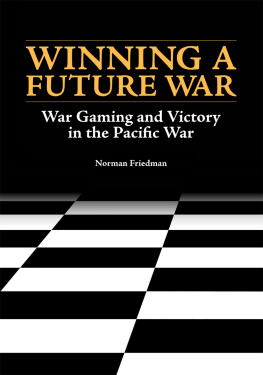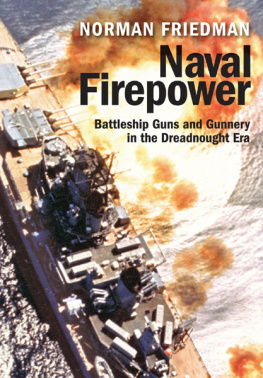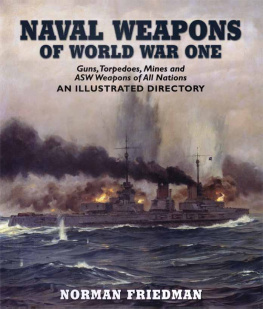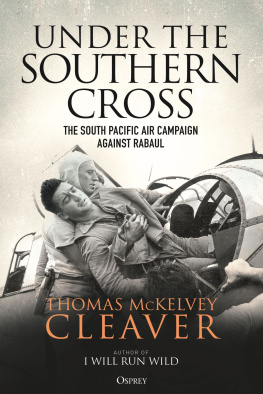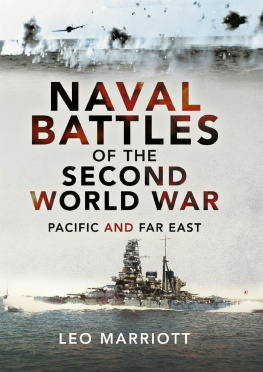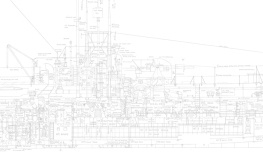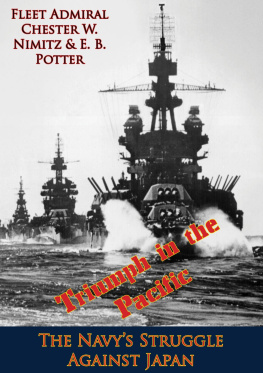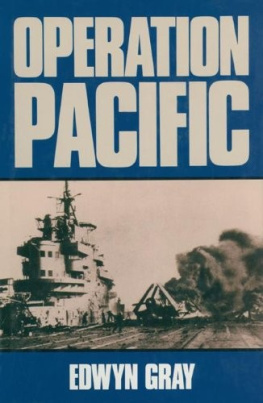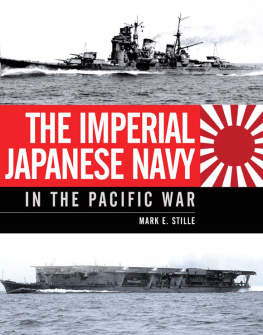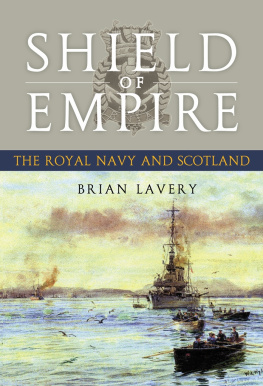Naval History and Heritage Command, Department of the NavyWashington, DCPublished by
Naval History and Heritage Command805 Kidder Breese Street SE
Washington Navy Yard, DC 20374-5060www.history.mil
Use of ISBN
This is the official U.S. Government edition of this publication and is herein identified to certify its authenticity. Use of 978- 1-943604-24-1 is for this edition only. The section 508compliant PDF of this title is cataloged under ISBN 978-1-943604-25-8. The titles e-book edition is cataloged under ISBN 978-1-943604-45-6.
Library of Congress Cataloging-in-Publication DataNames: Friedman, Norman, 1946 author.
Title: Winning a future war: war gaming and victory in the Pacific war/Norman Friedman.Other titles: War gaming and victory in the Pacific war
Description: Washington, DC: Naval History and Heritage Command, Department of the Navy,[2017] | Includes bibliographical references and index.
Identifiers: LCCN 2017050896 | ISBN 9781943604241
Subjects: LCSH: United States. NavyManeuversHistory20th century. | Pacific AreaDefenses. | World War, 19391945Pacific Area. | Naval ManeuversUnited StatesHistory20th century. | War games, NavalUnited StatesHistory20th century. | Naval War College (U.S.)History20th century. | Naval strategyStudy and TeachingUnited StatesHistory20th century.
Classification: LCC V245 .F76 2017 | DDC 359.4/80973dc23 LC record available at https://lccn.loc.gov/2017050896

In memory of Captain Hugh Nott, USN
Contents
Acknowledgments......................................... ix
vii
viiiWinning a Future War T
Acknowledgments
T
his book began with the observation by Captain Jerry Hendrix, USN (Ret.), who wasthen director of the Naval History and Heritage Command (NHHC), that there wasno history of inter-war gaming at the Naval War College in Newport comparable to thedetailed histories of the full-scale Fleet Problems (fleet exercises). I am grateful to CaptainHendrix both for initiating this project and for impelling me to collect material covering thefull range of games played at the college; I would never have done so without the sponsorship of the Naval History and Heritage Command. In turn, the gaming material becamethe basis for this book. I should emphasize that it was the full range of material that led meto the conclusions in this book, not any one particular game. I am grateful to Dr. EvelynCherpak, now retired, who, as archivist at the Naval War College, made it possible for meto review the gaming material and to copy a great deal of it. I had been visiting Dr. Cherpakand her archive for some years, but had always shied away from the sheer mass of gamingmaterial in the past. The advent of the digital camera, and the impetus provided by CaptainHendrix, changed that. After Dr. Cherpak retired, I benefitted from the assistance of interim archivist Scott Reilly and his assistant (later archivist) Dara Baker. Since important material, including gaming material, was held elsewhere, I visited several other archives. Thus,I am also grateful to the archivists of the National Archives, both in downtown Washington, DC, and at College Park, Maryland; to the Admiralty Librarian Jenny Wraight; and tothe archivists at the British National Archives at Kew. For their very enlightening insightsand comments on the ongoing project, I would like to thank my friends Chris Carlson, Dr.Thomas Hone, Trent Hone, David Isby, and Christopher C. Wright. At the Naval Historyand Heritage Command, Dr. Ryan Peeks provided a wide variety of assistance as well asvery helpful comments. Earlier, I benefitted from the efforts of Curtis Utz, who was mycontract officer at NHHC. I would also like to thank Kristina Gianotta, who, as head ofthe Histories Branch, managed this project. Far from last, I would like to thank my wife,Rhea, for her sustained loving and patient encouragement and support.
Acknowledgments ix MongoliaManchuria
KoreaJapan
PACIFICOCEAN
China
FormosaIwo JimaMidwayIslands
HongKongHawaiianIslandsMarianaIslandsLuzon
South
Philippines French
Indochina ChinaSea
Guam
NorthMindanaoBorneo
Sarawak
TrukPalau
IslandsCaroline IslandsSolomon
IslandsMarshallIslands
Makin
BorneoCelebes
BismarckArchipelagoGilbertIslands New Guinea SolomonIslands JavaPapua GuadalcanalElliceIslands Australia
Luzon Strait
LingayenGulf Luzon PhilippineSea
Manila SubicManilaBayBay
Bataan Mindoro
MastateSamar
PanayLeyte Manila LeyteBayGulf
Cebu DinagatIsland
Panaon NegrosBohol Island
Palawan SuluSea Mindanao Moro Gulf Malaysia CelebesSea
Introduction
T
o win the Pacific War, the U.S. Navy had to transform itself technically, tactically, and strategically. It had to create a fleet capable of the unprecedented feat of fighting and winning far from home, without existing bases, in the face of an enemy with numerous bases fighting in his own waters. Much of the credit for the transformation should go to the war gaming conducted at the U.S. Naval War College. Conversely, as we face further demands for transformation, the inter-war experience at the War College offers valuable guidance as to what works, and why, and how.
The fruits of this transformation are so commonplace now that we may easily forget how radical it was. The U.S. Navy emerged from World War I as a battleship fleetsimilar to other navies. The British had demonstrated that naval aircraft could be avital auxiliary to the battleships, but anything more was a distant prospect. The warhad demonstrated that an amphibious operation could be mounted in the face of resistance, but not that it would be particularly effective. In 194345, carriers were the accepted core of the U.S. fleet, and amphibious operations against enemy shore defenseswere routinely conducted. Indeed, without them it would have been impossible to fightWorld War II.
If it seems obvious that any naval officer aware of the march of technology would have developed the massed carriers and the amphibious fleet, the reader might reflect that the two other major navies failed to do so. The Japanese did create a powerful carrier striking force, but they made no real effort to back it up with sufficient reserves to keep it fighting. They developed very little amphibious capability useful in the face of shore defenses: They could not, for example, have assaulted their own fortified islands, let alone Normandy or southern France. The British built carriers, but accepted very small carrier air groups because, until well into World War II, they saw their carriers mainly as support for their battle fleet. Like the Japanese, they did not develop an amphibious capability effective against serious defense. Each of the three navies was staffed by excellent officers, often with the widest possible experience. What set the U.S. Navy apart?
War gaming at the U.S. Naval War College at Newport, Rhode Island, seems to have been a large part of the answer.
The games played by students there were a vital form of training, but at least as importantly, the games served as a laboratory for the U.S. Navy. It seems to have been significant that, until 1934, the Naval War College was part of the Office of the Chief of Naval Operations (OPNAV) rather than part of the naval school system. Gaming experience fed back into full-scale exercises (Fleet Problems), and full-scale experience fed back into the detailed rules of the games, which were conceived as a way of simulating reality as closely as possible. Game data were also fed to the U.S. Navys war planners, all of whom had graduated from the War College and thus had considerable game experience. The successes and failures of simulation give some guidance into what is needed in current and future games.
Next page 
